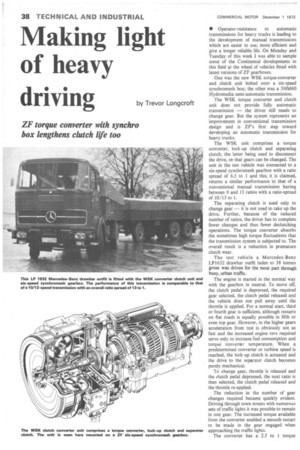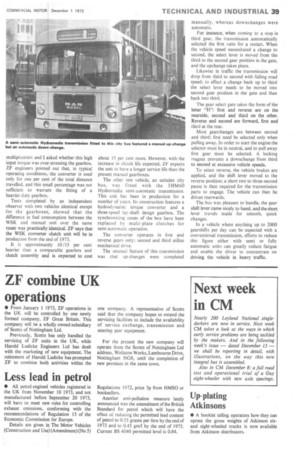Making light of heavy
Page 40

Page 41

If you've noticed an error in this article please click here to report it so we can fix it.
driving by Trevor Longeroft
ZF torque converter with synchro box lengthens clutch life too
• Operator-resistance to automatic transmissions for heavy trucks is leading to the development of manual transmissions which are easier to use, more efficient and give a longer reliable life. On Monday and Tuesday of this week I was able to sample some of the Continental developments in this field at the wheel of vehicles fitted with latest versions of ZF gearboxes.
One was the new WSK torque-converter and clutch unit bolted onto a six-speed synchromesh box; the other was a 3HM60 Hydromedia semi-automatic transmission.
The WSK torque converter and clutch unit does not provide fully automatic transmission — the driver still needs to change gear. But the system represents an improvement in conventional transmission design and is ZF's first step toward developing an automatic transmission for heavy trucks.
The WSK unit comprises a torque converter, lock-up clutch and separating clutch, the latter being used to disconnect the drive, so that gears can be changed. The unit in the test vehicle was connected to a six-speed synchromesh gearbox with a ratio spread of 6.5 to 1 and this, it is claimed, returns a similar performance to that of a conventional manual transmission having between 9 and 13 ratios with a ratio-spread of 10/13 to 1.
The separating clutch is used only to change gear — it is not used to take up the drive. Further, because of the reduced number of ratios, the driver has to complete fewer changes and thus fewer declutching operations. The torque converter absorbs the sometimes high torque fluctuations that the transmission system is subjected to. The overall result is a reduction in premature clutch wear.
The test vehicle a Mercedes-Benz LP1632 drawbar outfit laden to 38 tonnes gross was driven for the most part through busy, urban traffic.
The engine is started in the normal way with the gearbox in neutral. To move off, the clutch pedal is depressed, the required gear selected, the clutch pedal released and the vehicle does not pull away until the throttle is applied. For a normal start, third or fourth gear is sufficient, although restarts on flat roads is equally possible in fifth or even top gear. However, in the higher gears acceleration from rest is obviously not as fast and the increased engine revs required serve only to increase fuel consumption and torque converter temperature. When a predetermined converter or turbine speed is reached, the lock-up clutch is actuated and the drive to the separater clutch becomes purely mechanical.
To change gear, throttle is released and the clutch pedal depressed, the next ratio is then selected, the clutch pedal released and the throttle re-applied.
The reduction in the number of gear changes required became quickly evident. Driving through town streets with numerous sets of traffic lights it was possible to remain in one gear. The increased torque available from the converter enabled a smooth restart to be made in the gear engaged when approaching the traffic lights.
The converter has a 2.5 to 1 torque multiplication and I asked whether this high input torque was over-stressing the gearbox. ZF engineers pointed out that, in typical operating conditions, the converter is used only for one per cent of the total distance travelled, and this small percentage was not sufficient to warrant the fitting of a heavier-duty gearbox.
Tests completed by an independent observer with two vehicles identical except for the gearboxes, showed that the difference in fuel consumption between the WSK and manual unit over the same route was practically identical. ZF says that the WSK converter clutch unit will be in production from the end of 1973.
It is approximately 10/15 per cent heavier than a comparable gearbox and clutch assembly and is expected to cost about 15 per cent more. However, with the increase in clutch life expected, ZF expects the unit to have a longer service life than the present manual gearboxes.
The other test vehicle, an unladen city bus, was fitted with the 3HM60 Hydromedia semi-automatic transmission. This unit has been in production for a number of years. Its construction features a hydrodynamic torque converter and a three-speed lay-shaft design gearbox. The synchronizing cones of the box have been replaced by multi-plate clutches for semi-automatic operation.
The converter operates in first and reverse gears only; second and third utilize mechanical drive.
The unusual feature of this transmission was that up-changes were completed manually, whereas downchanges were automatic.
For instance, when coming to a stop in third gear, the transmission automatically selected the first ratio for a restart. When the vehicle speed necessitated a change to second, the select lever is moved from the third to the second gear position in the gate, and the upchange takes place.
Likewise in traffic the transmission will drop from third to second with falling road speed; to effect a change back up to third the select lever needs to be moved into second gear position in the gate and then back into third.
The gear select gate takes the form of the letter "H": first and reverse are on the nearside, second and third on the other. Reverse and second are forward, first and third at the rear.
Most gearchanges are between second and third; first need be selected only when pulling away. In order to start the engine the selector must be in neutral, and to pull away first gear must be selected. A locking magnet prevents a downchange from third to second at excessive vehicle speeds.
To select reverse, the vehicle brakes are applied, and the shift lever moved to the reverse position; a short two to three-second pause is then required for the transmission parts to engage. The vehicle can then be driven rearwards.
The bus was pleasant to handle, the gear shift lever came nicely to hand, and the short lever travels made for smooth, quick changes.
In a vehicle where anything up to 2000 gearshifts per day can be expected with a conventional transmission, efforts to reduce this figure either with semi or fully automatic units can greatly reduce fatigue and enable the driver to concentrate on driving the vehicle in heavy traffic.
































































































































